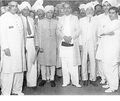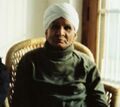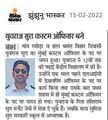Shoor
Shoor (शूर)[1] Sura (सूरा)[2]/ Soora (सूरा)[3] Soor (सूर)[4] Surah (सुराह) Shoora (शूरा) Suria/Suriya (सूरिया) Shoorsen/Shursen (शूरसैन)[5] is gotra of Jats found in Haryana, Rajasthan[6], Madhya Pradesh and Madhya Pradesh. It is a branch of Chauhans. Sur clan found in Afghanistan. [7] They fought Mahabharata War in Kaurava's side.
Origin
- This gotra is said to be originated from Maharaja Shura (शूर) descendant of Maharaja Viduratha (विदूरथ). [8]
- The clan may also get name from Buddhist King Suratissa (247 - 237 BC) who was an early monarch of Sri Lanka of the Kingdom of Anuradhapura. He was the younger son of Pandukabhaya and the brother of Mutasiva.
Jat Gotras Namesake
Jat Gotras Namesake
- Soora = Surae =Surve = (Pliny.vi.22)
- Sur = Surae =Surve = (Pliny.vi.22)[9]
- Sura (Jat clan) = Sur River. Sur River is a river of Nagpur district in Maharashtra, India. Ankollika (अङ्कोल्लिक) (L.17), mentioned in Nagardhan Plates Of Svamiraja : (Kalachuri) Year 322 (=573 AD), which was situated on the bank of the Shulanadi, has been identified by Vasudev Vishnu Mirashi with modern Aroli, on the right bank of the Sur River, about 8 miles south by east of Nagardhan.[10] Our view is that this village may be Akoli in Kuhi tehsil in Nagpur district of Maharashtra.
- Sura (Jat clan) = Sur River (सुरनदी) (L.39). Sur River (सुरनदी) (L.39) is mentioned in Ramtek stone inscription of Ramachandra [11]
Mention by Panini
Sura (सुरा) is mentioned by Panini in Ashtadhyayi. [12]
Mention by Pliny
Pliny[13] mentions 'The Indus.'....Below these deserts are the Dari and the Surve, and then deserts again for one hundred and eighty-seven miles, sands in general encircling these spots just as islands are surrounded by the sea. Below these deserts, again, are the Maltecoræ, the Singæ, the Marohæ, the Rarungæ, and the Morontes. These last peoples, who possess the mountains throughout the whole range of country as far as the shores of the ocean, are free, and independent of all kings, and hold numerous cities upon the declivities of the mountains.
Jat clans mentioned by Megasthenes
Megasthenes also described India's caste system and a number of clans out of these some have been identified with Jat clans by the Jat historians. Megasthenes has mentioned a large number of Jat clans. It seems that the Greeks added 'i' to names which had an 'i' ending. Identified probable Jat clans have been provided with active link within brackets. (See Jat clans mentioned by Megasthenes)
| Jat clans as described by Megasthenes | ||||||||||||
| Location | Jat clans | Information | ||||||||||
|---|---|---|---|---|---|---|---|---|---|---|---|---|
| 10. Below the deserts are | The Dari (Dar, Dara, Darwal), the Surae (Sur, Sauran, Soora, Surve), the Maltecorae (Maltiya), Singhae (Sangha, Singa, Singad, Singala, Singhal, Singhar, Singwa), Marohae (Maru, Maurya, Marohi), Rarungae (Rangi,Rara), Moruni (Mor) | These inhabit the hills which in an unbroken chain run parallel to the shores of the ocean. They are free and have no kings, and occupy the mountain heights, whereon they have built many cities | ||||||||||
Surabera
- सुरबेरा (जाट गोत्र - सूरा) : सुरबेरा नाम का गाँव झारखंड के सराइकेला खरसावाँ जिले की कुचाई विकास-खंड में है।
In Mahavansa
Mahavansa/Chapter 21 tells ...Mahäsiva's younger brother, Suratissa, reigned after his death ten years, zealously mindful of meritorious works. In the southern quarter (of the city) he founded the Nagarangana-vihara, in the eastern quarter the vibära (called) Hatthikkhandha and the Gonnagirika (vihara) on the Vangutrara-mountain the (vihära) named Pacinapabbata and near Raheraka the (vihära) Kolambahalaka; at the foot of the Arittha (mountain) the Makulaka (vihära), to the east the Acchagallaka (vihara), but the Girinelavahanaka (vihara) to the north of Kandanagara; these and other pleasing viharas, in number five hundred, did the lord of the earth build on this and the further bank of the river, here and there in the island of Lanka, before and while he reigned, during the period of sixty years, piously and justly, devoted to the three gems. Suvannapindatissa was his name before his reign, but he was named Süratissa after the beginning of the reign.
Two Damilas, Sena and Guttika, sons of a freighter who brought horses hither,' conquered the king Süratissa, at the head of a great army and reigned both (together) twenty-two years justly. But when Asela had overpowered them, the son of Mutasiva, the ninth among his brothers, born of the same mother, he ruled for ten years onward from that time in Anuradhapura.
Mahavansa/Chapter 23 tells.... King Kakavannatissa caused a guard to hold the Damilas in check to be kept continually at all the fords of the Mahäganga. Now the king had, by another wife, a son named Dighabhaya; and he gave the guard near the Kacchaka ford into his charge. And to form the guard this (prince) commanded each noble family within a distance of two yojanas round (to send) one son thither. Within the district of Kotthivala, in the village of Khandakavitthika, lived the chief of a clan the headman named Samgha who had seven sons. To him, too, the prince sent a messenger demanding a son. His seventh son named Nimila had the strength of ten elephants. ....The king gave him (into the service of) the prince Gamani, and with high honours the warrior Süra Nimila took up his abode with him. (Süra Nimila → Sura)
History
Hukum Singh Panwar[14] has given the ancestry of Bharatpur rulers starting from 1. Yadu. Shura is at S.No. 37 and Krishna at S.No. 43 as under[15]:
34. Andhaka → 35. Bhajmana → 36. Viduratha → 37. Shura → 38. Shini → 39. Bhoja → 40. Hardika → 41. Devamidha → 42. Vasudeva → 43. Krishna → 44. Pradyumna
Shoor people were the rulers of Bateshwar (बटेश्वर). They were so powerful that the entire country was named Shaursain (शौरसैन) after them. Shaursaini (शौरसैनी) people were at Bharatpur, whose one branch was known as Sewar/Sevar (सेवर). [16]
Mahabharata mentions a Suryasura and obviously not for the sun (Surya) but for the Sura people [17] Darada (the Darar clan people) a king of Bahlika was born from Surya. [18] The Sura Kings came for Yudhisthira’s sacrifice. [19]
The Mahabharata Tribe - Sura (शूर) may be identified with Jat Gotra - Shura (शूरा)
Megasthenes has mentioned them as Suari in his book Indica. ( See - Jat clans as described by Megasthenes)
शूर: ठाकुर देशराज
ठाकुर देशराज[20] ने लिखा है ....शूर - इन्हें सौरसेनों के नाम से भी याद किया जाता है। महाभारत के बाद इनके भी दो दल हो गए थे। एक दल की राजधानी मथुरा थी। कुछ दिन बाद शौरसेनी (सिनसिनी) बना ली। इनमें से विजयदेव ने बयाना को अपनी राजधानी बनाया। इनका दूसरा समुदाय सोरों और बटेश्वर के बीच में आबाद था।
शूरसेन-शूर का इतिहास
दलीप सिंह अहलावत[21] लिखते हैं:
यह चन्द्रवंशी जाट गोत्र है जो कि रामायणकाल से ही सुप्रसिद्ध रहा है। सुग्रीव ने सीता जी की खोज के लिए वानर सेना को उत्तर दिशा के शूरसेन, भरत (इन्द्रप्रस्थ क्षेत्र), कुरु आदि देशों में जाने का आदेश दिया (वा० रा० किष्किन्धाकाण्ड सर्ग 43)। शत्रुघ्न ने मधुपुत्र लवणासुर को मारकर मथुरा नगर बसाया। उसके पुत्र सुबाहु व शूरसेन ने मथुरा पर राज्य किया। शत्रुघ्न ने शूरसेन जनपद व उसकी राजधानी मधुरापुरी (मथुरा) को पूर्णरूप से बसाया। (वा० रा० उत्तरकाण्ड सर्ग 70, 108)।
महाभारतकाल में इनके वृज में दो राज्य थे। ये लोग कृष्ण जी के बनाए हुए ज्ञाति संघ में मिल गये थे। इन लोगों ने महाभारत युद्ध में भाग लिया था। महाभारत के बाद इनके दो दल हो गये थे। एक दल की राजधानी मथुरा थी। कुछ दिन बाद इन लोगों ने डीग के पास सिनसिनी (पहला नाम शूरसेनी) गांव को अपनी राजधानी बनाया। इन लोगों में से विजयदेव ने बयाना को अपनी राजधानी बनाया। इनका दूसरा सम्प्रदाय सोरों और बटेश्वर के बीच में आबाद था। शूरसेन जाटों का प्रभाव व सभ्यता यहां तक बढ़ी-चढ़ी थी कि उत्तरी भारत में बोली जाने वाली भाषा ही उनके नाम से शूरसेनी कहलाती थी। शूरसेनी भाषा इटावा से लेकर मन्दसौर तक और पलवल से रतलाम तक बोली जाने वाली भाषा है। (जाट इतिहास पृ० 132, लेखक ठा० देशराज)
बौद्धकाल के समय भारतवर्ष में 16 महाजनपद (राज्य) थे जिनमें एक शूरसेन राज्य भी था। इन शूर जाटों ने मुगलों से लोहा लिया। वीर योद्धा गोकुला का जन्म इसी सिनसिनी गांव में हुआ था जिसने औरंगजेब के साथ बड़ी वीरता व साहस से युद्ध किये और अन्त में पकड़े जाने
जाट वीरों का इतिहास: दलीप सिंह अहलावत, पृष्ठान्त-257
पर मुसलमान बनना अस्वीकार करके शहीद हो गया। भरतपुर नरेशों का गोत्र शूरसेन था जो बाद में सिनसिनी या सिनसिनवार कहलाया। इन सब बातों का वर्णन भरतपुर राज्य अध्याय में विस्तार से किया जायेगा।
आज भी शूरसेन-सिनसिनवार गोत्र के जाट वृज तथा यू पी० में बड़ी संख्या में हैं।
Villages founded by Shoora clan
- Shoora ka Bas (शूरा का बास) - Villages in Jhunjhunu district in Rajasthan.
- Soorwas (शूरवास)- village in Sujangarh tehsil of Churu district in Rajasthan.
- Soorpura Dudu (सूरपुरा) - village is in Dudu tahsil of district Jaipur in Rajasthan.
- Suron Ka Bas (सुरों का बास) - village in Jhunjhunu tahsil & district in Rajasthan.
Distribution in Haryana
Surah gotra Jats are found in District Jind and Sonipat (Jagsi) (Gohana).
Villages in Hisar district
Villages in Kurukshetra district
Sura Thanesar is the name of a village in Thanesar tahsil of Kurukshetra district in Haryana.
Villages in Sonipat district
Gohana [ [ Jagsi ] ]
Distribution in Rajasthan
Soora Jats are found in Jaipur, Jhunjhunu and Sikar districts in Rajasthan.
Locations in Jaipur city
Abhinav Nagar, Sanganer, Shastri Nagar, Sukhia (Muhana), vidhyadharnagar , Centarspine Muhana,
Villages in Sikar district
Villages in Churu district
Villages in Jhunjhunu district
Niwai,, Rasoda, Shoora ka Bas, Suron Ka Bas
Distribution in Madhya Pradesh
Villages in Ratlam district
Villages in Ratlam district with population of this gotra are:
Salakhedi 1,
Villages in Indore district
Notable persons
- Devak Ram Surah ADVOCATE (1904-1998) L.L.B. RAMJAS COLLEGE DELHI , B.A. D.A.V.College Lahore ( Dayanand Anglo Vedic ) He was divisonal Panchayat Officer Haryana and Punjab Head officer Ambala He was in freedom movement, Chairman consumer Cooperative board of Haryana stateChandigarh He was from Jagsi - Gohana - Sonipat a public servant during all his life fighting for whole of Haryana for Kisans and all schedule caste and whole community,"A NOBLE KIND MAN" who served his country selflessly.Chaudhary Devak Ram Surah was also a good football player during his school and played in Gohana magistrate Court team sitting next to Judge Magistrate in group picture.He was also a lawyer for Gohana Magistrate Court,also practice lawyer Advocate Bar association courts Rohtak,Panipat,Chanidigarh, Haryana Punjab,Delhi.
- Ram Singh Soora - Adhyaksh Bharatiy Kisan Sangh Indore, Heer Singh Jat Soora Indore, Mob:9300963251.
- Nand Lal Sura - Village: Jaipuria Khalsa (Rajgarh), Donated Rs 51000 for construction of Karma Bai Kanya Chhatrawas Churu. Social reformer, opposes social evils like dowry, child marriage etc.
- Mr. Dalpat Singh Sura - Admn. Officer C&AG Finance, 840-C, Malik Colony, New Court Road, Sonipat Haryana, 011-23221668, 0130-2221222, 9868123567 NCR (PP-362)
- Amit Shoora: Danics / Assistant commissioner, Car Nicobar, Andaman, M: 9531916739
Gallery of Shura Surah Shoor people
-
Devak Ram Surah (1904-1998) awarded with Tamrapatra given by Haryana State Government on 26 January 2016.
-
Chairman of consumer cooperative board of Haryana State in Chandigarh 1978
-
Devak Ram Surah political prisoner of Indra Gandhi emergency rule 1977 to 1979
-
Devak Ram Surah Lawyer, pictured in the middle line third from the left sitting next to Magistrate Gohana Court of law Football team.
-
Devak Ram Surah second left Sir Chotu Ram Sir Siknder Hayt 1940.
-
Shri Devak Ram Surah Advocate.
-
Devak Ram Surah Advocate
-
Devak Ram Surah Advocate
-
Devak Ram Surah Advocate
-
Devak Ram Surah Advocate
-
Devak Ram Surah Advocate.Young Lawyer Gohana Magistrate Court.
-
Devak Ram Surah. Advocate 1996 (Rohtak)
-
-
-
-
-
Shri Nand Lal Sura. Village Jaipuria Khalsa (Rajgarh)
-
Yuv Raj Sura - Custom Officer from Rasora Jhunjhunu
References
- ↑ Jat History Dalip Singh Ahlawat/Parishisht-I, s.n. श-4
- ↑ Jat History Dalip Singh Ahlawat/Parishisht-I, s.n. स-186
- ↑ O.S.Tugania:Jat Samuday ke Pramukh Adhar Bindu, p.63, s.n. 2500
- ↑ Jat History Dalip Singh Ahlawat/Parishisht-I, s.n. स-186
- ↑ Jat History Dalip Singh Ahlawat/Parishisht-I, s.n. श-4
- ↑ जाट इतिहास:ठाकुर देशराज,पृष्ठ-695
- ↑ An Inquiry Into the Ethnography of Afghanistan, H. W. Bellew, p.27,93,118,120,135,138,168,180,185
- ↑ Mahendra Singh Arya et al: Adhunik Jat Itihas, p. 281
- ↑ Bhim Singh Dahiya:Jats the Ancient Rulers (A clan study)/Porus and the Mauryas,p.167,s.n.16
- ↑ Corpus Inscriptionium Indicarium Vol IV Part 2 Inscriptions of the Kalachuri-Chedi Era, Vasudev Vishnu Mirashi, 1905, p.611-617
- ↑ Mirashi and L.R. Kulkarni, Epigraphia Indica, Vol. XXV, 1939-40, pp.7-20
- ↑ V. S. Agrawala: India as Known to Panini, 1953, p.115, 246
- ↑ Natural History by Pliny Book VI/Chapter 23
- ↑ The Jats:Their Origin, Antiquity and Migrations/Appendices/Appendix No.1
- ↑ Yadu Vamsavali of Bharatpur given by Ganga Singh in his book 'Yadu Vamsa', Part 1, Bharatpur Rajvansa Ka Itihas (1637-1768), Bharatpur, 1967, pp. 19-21
- ↑ Mahendra Singh Arya et al: Adhunik Jat Itihas, p. 281
- ↑ ibid, 1 / 67 / 58
- ↑ ibid , 2 / 44/8
- ↑ Bhim Singh Dahiya, Jats the Ancient Rulers ( A clan study), p. 289
- ↑ Jat Itihas (Utpatti Aur Gaurav Khand)/Pancham Parichhed ,p.98
- ↑ जाट वीरों का इतिहास: दलीप सिंह अहलावत, पृष्ठ.257-258
Back to Gotras


















